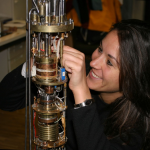

- Photon Transport in a Bose-Hubbard Chain of Superconducting Artificial Atoms
G. P. Fedorov et al., Phys. Rev. Lett. 126, 180503 (2021) - Path-Dependent Supercooling of the
He3 Superfluid A-B Transition
Dmytro Lotnyk et al., Phys. Rev. Lett. 126, 215301 (2021) - Superconductivity in an extreme strange metal
D. H. Nguyen et al., Nat Commun 12, 4341 (2021) - High-Q Silicon Nitride Drum Resonators Strongly Coupled to Gates
Xin Zhou et al., Nano Lett. 21, 5738-5744 (2021) - Measurement of the 229Th isomer energy with a magnetic micro-calorimeter
T. Sikorsky et al., Phys. Rev. Lett. 125 (2020) 142503
Utilization of the superconducting transition for characterizing low-quality-factor superconducting resonators
Y.-C. Chang, B. Karimi, J. Senior, A. Ronzani, J. T. Peltonen, H.-S. Goan, C.-D. Chen, J. P. PekolaCharacterizing superconducting microwave resonators with highly dissipative elements is a technical challenge, but a requirement for implementing and understanding the operation of hybrid quantum devices involving dissipative elements, e.g., for thermal engineering and detection. We present experiments on λ/4 superconducting niobium coplanar waveguide resonators, terminating at the antinode by a dissipative copper microstrip via aluminum leads, such that the resonator response is difficult to measure in a typical microwave environment. By measuring the transmission both above and below the superconducting transition of aluminum, we are able to isolate the resonance. We then experimentally verify this method with copper microstrips of increasing thicknesses, from 50 nm to 150 nm, and measure quality factors in the range of 10-67 in a consistent way.
Appl. Phys. Lett. 115, 022601 (2019)
doi: 10.1063/1.5098310
arxiv: https://arxiv.org/abs/1904.01781















